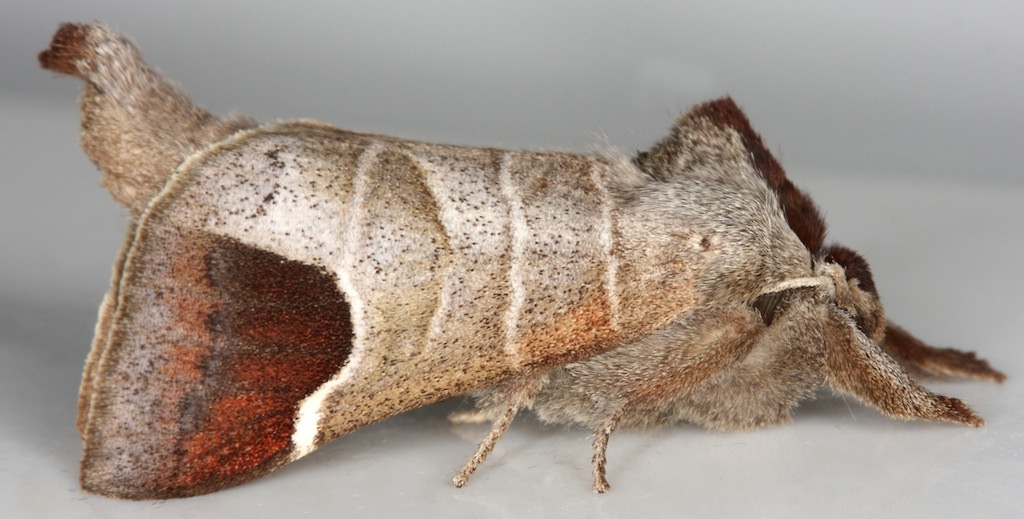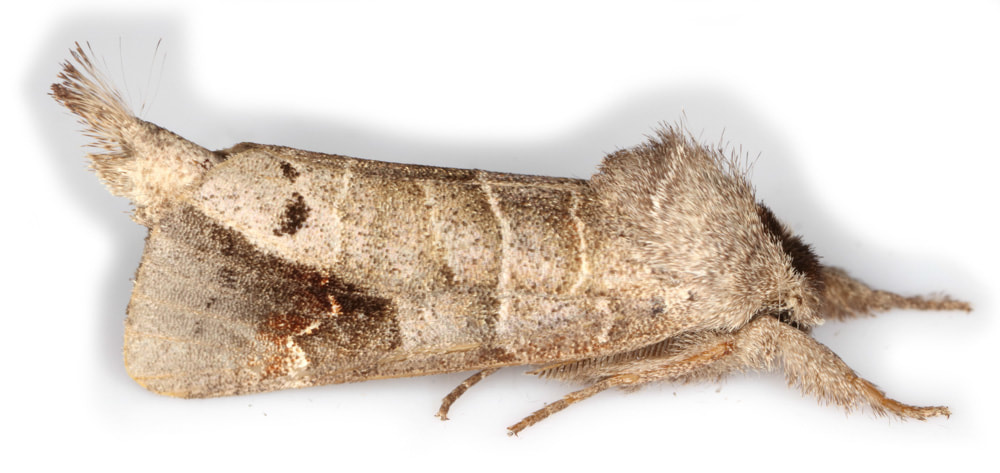Long-winged, heavy-bodied; wings held in tectiform position at rest; antennae bipectinate in male, with shorter pectinations or ciliate in female; adults do not feed and proboscis may be developed, rudimentary or absent; tympanal organ on metathorax; tibial spurs serrate.
Subfamily: Thaumatopoeinae are the 'Processionary' moths - reflecting the fact that the larvae leave their silken webs in procession at night to feed. They have previously been treated as a separate family (Thaumatopoidae) or within the family: Noctuidae
Subfamily: Crerurinae include the Puss Moth - reflecting its hairiness, and the 'Kittens' - which resemble small Puss Moths
Subfamily: Notodontinae are the 'Prominents' - referring to a projecting scale-tooth from the forewing dorsum (notodonta = "tooth-back")
Hindtibia with only one pair of spurs in subfamilies Cerurinae and Dicranurinae, 2 pairs in Notodontinae
Subfamily: Thaumatopoeinae are the 'Processionary' moths - reflecting the fact that the larvae leave their silken webs in procession at night to feed. They have previously been treated as a separate family (Thaumatopoidae) or within the family: Noctuidae
Subfamily: Crerurinae include the Puss Moth - reflecting its hairiness, and the 'Kittens' - which resemble small Puss Moths
Subfamily: Notodontinae are the 'Prominents' - referring to a projecting scale-tooth from the forewing dorsum (notodonta = "tooth-back")
Hindtibia with only one pair of spurs in subfamilies Cerurinae and Dicranurinae, 2 pairs in Notodontinae
Subfamily: Thaumetopoeinae (1G 2S)
Thaumetopoea (2S)
Thaumetopoea (2S)
Subfamily: Cerurinae (2G5S)
Cerura (2S)
Cerura (2S)
Furcula (3S)
Antenna bipectinate, the pectinations shorter in female; labial palps very short, proboscis reduced; hindtibia with 1 pair of short spurs.
Antenna bipectinate, the pectinations shorter in female; labial palps very short, proboscis reduced; hindtibia with 1 pair of short spurs.
Subfamily: Dicranurinae (2G 2S)
Subfamily: Notodontinae (8G+1EX 14S+1EX)
Drymonia (2S)
Antenna bipectinate in male, simple in female; proboscis reduced; labial palps short; eyes glabrous; ocelli absent; hindtibia with 2 pairs of spurs.
Antenna bipectinate in male, simple in female; proboscis reduced; labial palps short; eyes glabrous; ocelli absent; hindtibia with 2 pairs of spurs.
Notodonta (4S)
Antenna bipectinate in male, denticulate in female; proboscis reduced; labial palps short; eyes hairy; ocelli absent; hindtibia with 2 pairs of spurs.
Antenna bipectinate in male, denticulate in female; proboscis reduced; labial palps short; eyes hairy; ocelli absent; hindtibia with 2 pairs of spurs.
019 Leucodonta bicoloria (White Prominent) - EXTINCT in GB, but small numbers survive in Ireland
Subfamily: Phaelerinae (1G 1S)
Phalera
025 Phalera bucephala (Buff-tip)
Phalera
025 Phalera bucephala (Buff-tip)
Subfamily: Pygaerinae (2G 4S)
Gluphisia
026 Gluphisia crenata (Dusky Marbled Brown)
Rare migrant with no British records since 1900 (1 in Jersey, 1995)
Gluphisia
026 Gluphisia crenata (Dusky Marbled Brown)
Rare migrant with no British records since 1900 (1 in Jersey, 1995)
Clostera (3S)






















